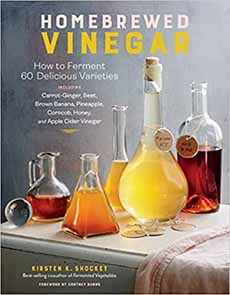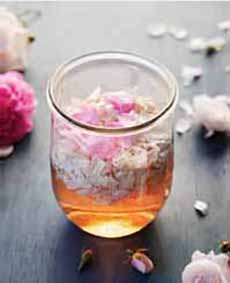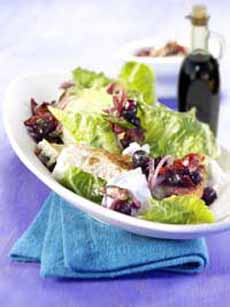Homebrewed Vinegar Book: Make Delicious Artisan Vinegar For Home & For Gifts
|
Mankind has been making vinegar for more than 10,000 years. It was inadvertently created alongside its alcoholic forbears—wine, beer, and other spirits. Vinegar quickly became a culinary staple as well as a health tonic. Vinegar can compliment dishes by delivering a complexity of flavors. While for most people, “vinegar” means apple cider vinegar, balsamic vinegar, distilled white vinegar and sherry vinegar, you can make flavor-infused vinegars with fruits (raspberry, maple, plum, e.g.), herbs (tarragon, herbs de Provence, e.g.) and spices (ginger, garlic, vanilla, e.g.). Fermentation expert Kirsten K. Shockey opens our eyes to making vinegar at home, with her new book, Homebrewed Vinegar: How to Ferment 60 Delicious Varieties, Including Carrot-Ginger, Beet, Brown Banana, Pineapple, Corncob, Honey, and Apple Cider Vinegar. The book is a deep dive into this ancient condiment, health tonic and kitchen staple. If you’re a great cook, or simply someone who loves great cooking, you’ll appreciate the world of vinegars in this book. And you don’t just explore: You’ll get inspired to make your own vinegar, for your home table and for gifts. While most of us think of grapes as the base for vinegar, vinegar can be made from any food that has fermentable sugar, from any other fruits to flowers, even to beer (after all, champagne, red and white wines, and sherry are commonly made into vinegar). In this era of sustainability, homemade vinegar is also a way to minimize kitchen waste. For example, you can make vinegar from the pulp left over from juicing, or from overripe mushy bananas. Intrigued? Read on! You’ll get the foundational skills and knowledge for fermenting your own vinegar. Head to your local bookseller, or find the book on Amazon. In addition to Homebrewed Vinegar, Kirsten K. Shockey is also the author, with her husband, Christopher Shockey, of The Big Book of Cidermaking; Miso, Tempeh, Natto & Other Tasty Ferments, Fiery Ferments, and the best-selling Fermented Vegetables: Creative Recipes for Fermenting 64 Vegetables & Herbs in Krauts, Kimchis, Brined Pickles, Chutneys, Relishes & Pastes. The Shockeys got their start in fermenting foods with their farmstead food company, where they created more than 40 varieties of cultured vegetables and krauts. Their current focus is on teaching the art of fermenting vegetables to others through classes and workshops at their farm—a 40-acre hillside homestead in the Applegate Valley of southern Oregon. > THE DIFFERENT TYPES OF VINEGAR ________________ *In ancient Greek, oxymel means “acid and honey.” The combination of vinegar and honey was a staple that was used for medicinal purposes from ancient times through the Victorian era. People still use it in homeopathy (alternative medicine). The word is also spelled oxymellus and oxymellis; the plural forms are oxymeli and oxymelli. |
|
|
|
|
||






